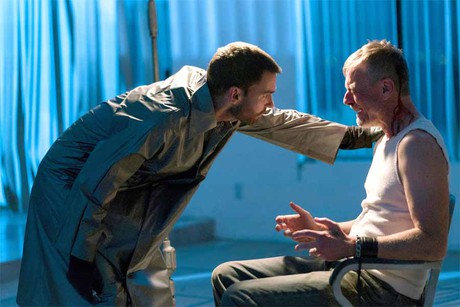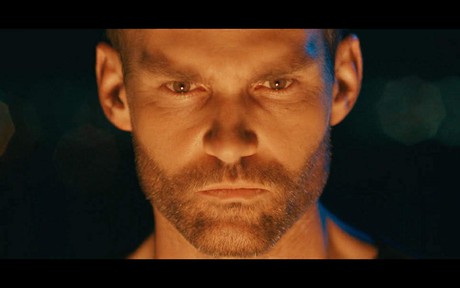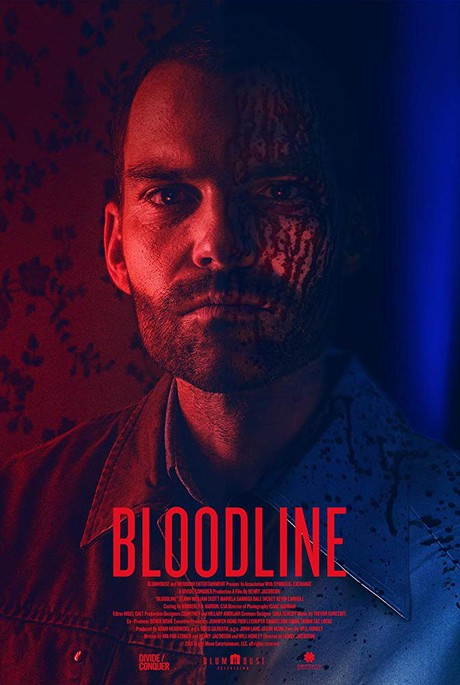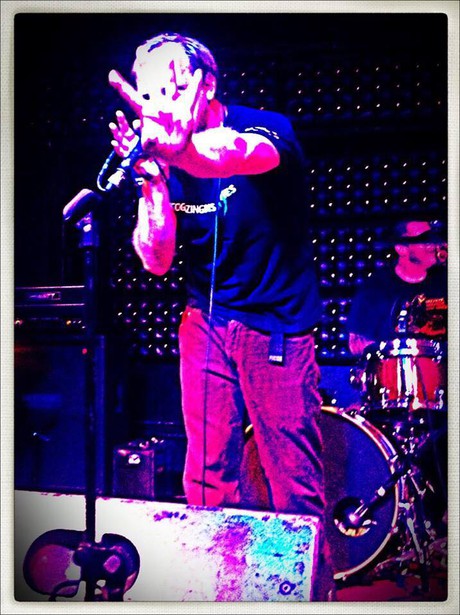Howdy, y’all! I recently got to check out Blumhouse’s latest horror/thriller BLOODLINE, starring Seann William Scott (AMERICAN PIE, THE RUNDOWN), and it delivers on all promises! Check out the trailer below:
Scott plays Evan Cole, a high school social worker who counsels threatened students by day and occasionally murders their tormentors at night. We spend the first half of the film learning about Evan; why he is what he is and what he hopes to achieve with his extracurricular activities. We met his family: wife Lauren, new son Andrew, and doting mother Marie. His life seems to be literally day and night, until an investigative dragnet starts to close in on him and the veneer of his perfect family starts to slowly peel back.
Watching the film, the first thing that stood out was just how great Seann William Scott is in the role of Evan. He courts a quiet mania in scenes that wouldn’t convey tension with a lesser performance, and lends the film the credibility that allows us to invest in Evan’s story. We’re never asked to side with him or against him; merely shown him, scientifically, as a case-study for different facets of a man. Is he a father, a son, a husband, or simply a monster? The question is completely ours, and that’s a beauty of Jacobson’s film.
I had the chance to chat with director/co-writer Henry Jacobson about the film, BlumHouse, working with Scott, and the happy gifts that come along with excellent casting.
Eric McClanahan: We’re talking about the movie BLOODLINE. Could you give me your quick elevator pitch of the film?
Henry Jacobson: It’s about a serial killer who has been on a serial-killing hiatus and has a baby and the stress of fatherhood sends him back out on a killing spree.
EM: [laughs] I like that. That’s good. So I saw that you co-wrote the script. Was the original story your idea?
HJ: No, so there was originally a script already set up at Blumhouse [by William Honley (THE HIVE)] with Seann already attached and they were looking for a director to work on it. I had been working on a different project with Avra Fox-Lerner which we pitched and they were like “That’s great; a little too weird. Look at this script.” So they sent us that and we talked about it for a while and pitched them a different take on the basic idea of “Serial Killer has a baby” and they said “great” and Avra and I went ahead and basically did a Page One rewrite on it.

EM: I wanted to ask right away: the film opens with a murder and as we view it we see that it’s actually towards the middle of the spree, somewhat in medias res. Why did you choose to open on the nurse?
HJ: A couple of reasons. One was a narrative device to set up the expectation of one direction then adding a twist that we knew was going to come later. Secondly, on a more film-history consciousness level we were opening up on a classic horror trope: The Shower Kill. Which serves to both later lead to that plot twist but also bring the audience to a place where they think they know what kind of movie this is. Hopefully they later reflect upon that assumption and we can play with and subvert that trope.
EM: I agree that I first assumed it was his first kill and later learned differently. I noticed when watching the credits that the name “Jacobson” showed up a couple of times in the credits. I understand that it’s a common name but was making this film something of a family affair?
HJ: [chuckles] When I got the script my wife was pregnant with our first child. And, yes, he’s actually in the movie. He plays baby Andrew. There’s a guy in the VFX team named Jacobson but there’s no relation.
EM: It’s a film called BLOODLINE. You’ve got to get your family involved.
HJ: That’s the way I thought about it. I’m like “I’m going to put my first baby in my first baby.”
EM: So you say Seann William Scott was already attached when you came to the project. Tell me about meeting with him and what he brought to the film.
HJ: After our initial pitch to Blumhouse we had to work out a larger outline of the story and I pitched it directly to Seann. It was a much darker direction than the original script and it seemed the darker it went the more excited he seemed to get. He loved the take. We worked together a lot on it, even when writing the script, and we both wanted to take it as dark as it possibly could go. I was surprised meeting him that he’s a huge horror fan; a huge horror buff. He really knows horror movies, and has always wanted to do something with that darker kind of character. Getting to work with someone of his caliber on this feature was an incredible gift. One was because of his professionalism. Working on this lower-budget production time is limited and he was able to nail it in the first couple of takes almost always. Two, he was so enthusiastic and passionate about the character and dove deeply into the research that we were doing. And three, he’s such a sweetheart. He’s a really lovely guy and was always a pleasure to have on set. He always came to work really energetic and positive; he was kind to everyone. We had a great time working with each other. I love that guy.
EM: He did great work in the film, too.

HJ: Yeah, it’s obviously a different kind of role for him and I hope that people take notice of that performance.
EM: Speaking of the shower scene and some of those classic horror tropes, what were some of those classic films that you sought to pay homage to and take inspiration from?
HJ: We talked a lot about visual influences. Blumhouse was kind enough to give us access to their screening room for a number of different screenings for me and my department heads. Some of the things we looked at were early Brian De Palma, like DRESSED TO KILL and BODY DOUBLE, which are two of my all-time favorite movies. Michael Mann in terms of color palate and use of the camera; we used almost no hand-helds in this movie so there’s a lot of similarities there to MANHUNTER which also dealt with a serial killer. We went back to the serial killer genre but veered at one point toward the neo-noir mystery kind of structure, which is something that Avra and I were very cognizant of even during the writing where some of the dialogue was reminiscent the sort of hard-boiled detective novels of the 40s and B-lot noirs of the 50s. So we looked at a lot of that stuff, too. One movie in particular that we watched was IN A LONELY PLACE, the Nicholas Ray movie where Bogart plays a potentially - you don’t know if this character is psychopathic. But ultimately I took away a lot from that visual references from that and it hadn’t even occurred to me that we pulled a bit of that from a story perspective for character. And our production designers (Courtney and Hillary Andujar) were huge giallo fans so they brought in the color and use of patterns in the set. It was a lot; a big conversation, one that began with Avra and I as we worked on the script. We went to high school together so we’ve been really close for years and years and years and have a lot of the same references so whenever we work on something it’s just natural to start bouncing around things that we love and are thinking about as we’re writing.
EM: Yeah, it enables you to create a bit of a shorthand in your conversations.
HJ: Exactly. And Isaac Bauman, our DP, was obsessive. Like, if he’s not on set, not working like a 16-hour work day, he literally, like clockwork, watches about four movies a day. And live-posts about them. That guy is obsessed; he’s trying to see everything. He has sort of an encyclopedic knowledge, too, which is pretty impressive. I was able to show him a couple of things he hadn’t seen, and likewise he showed me a few. And Seann, too. We talked about things that he was looking at and so on and so forth. There was a lot of that. And you know what: I straight up steal some things. I definitely steal from De Palma. It’s not a lack of originality, it’s more a love of what they did. I’m a firm believer in homage.
EM: Yeah, I made one film and when we were talking about certain shots I would actually call it by the name of the director, like “we gotta get the This Guy Shot” and they’d say “well, yeah, obviously.”
HJ: Yeah, sometimes it’s a joking thing. Where we’d be on set trying to think of how to light something or whatnot and I would joke “Well, what would De Palma do?” That became a bit of a running gag.
EM: With a film like BLOODLINE and its themes of family, and the life ahead of little baby Andrew, is it possible that these characters could be revisited later?
HJ: I mean, I would love that. I never thought of it that way, going into it, it never struck me as a natural candidate for a sequel. But if people want to see it, I’m down for sure.

EM: Maybe like a DOCTOR SLEEP thing, where Andrew’s all grown…
HJ: Oh, totally. It would have to be BLOODLINE 2: THE RISE OF ANDREW. It would definitely be his movie.
EM: Speaking of the dialogue and a lot of that noir, Detective Overstreet was such a large presence in the film. A lot of his dialogue, “I’m taught to look for patterns, to see connections…” Tell me about crafting that dialogue and working with the actor on that.
HJ: That was an interesting thing. His character is one of those examples of the power of casting. When Avra and I were working on that we really envisioned him as kind of that classic Bogart detective, you know? And so he’s written that way. We auditioned a lot of actors and one of them came in and did it exactly that way; you know, the fast talking, aggressive, trying to trip you up kind of character. And he was great, he was terrific. And then we got a tape from Kevin Carroll (VELVET BUZZSAW), who plays the role, and he gave us this very different take on it. Very quiet, almost seductive, allowing the characters to dig their own grave. It was never how we saw the character but once we saw him we were like “Oh my God, this is so interesting,” he had such a remarkable take on it. It ends up being one of the best performances in the movie. He’s just brilliant. So I think it’s just a testament to casting. Kimberly Hardin, our casting director, brought him in. The right actor or performance makes you as the writer or director think of your character in a whole different way. It presents a lot of new opportunities that you hadn’t accounted for in planning. And Mariela [Garriga] (NIGHTMARE CINEMA) was another example of that. We had written her character as more of a classic American girl-next-door grown up kind of character. Then we met Mariela and she did this incredible audition. We met with her afterwards and just for the audition she had like ten pages of research she’d done; notes and backstory she’d given the character. I looked at that performance and realized there’s a whole other element aside from just her incredible abilities as an actress, of her being an immigrant. There’s a lot of built-in backstory for that which saves us from having to write an expository scene that tells us she’s been separated from her family in some way and doesn’t have any other roots other than this family which is why she ends up sort of trapped in this family just by virtue of being from somewhere else. There are a number of assumptions that I think are often true about immigrants and being cut off from their homeland and from family. So, again, that was just another incredible gift that we had never envisioned in our preparation.
At this point we were asked to wrap it up as we’d gone over our time. It’s clear that Henry has a deep appreciation for cinema and affection for his performers. This comes through clearly in the film BLOODLINE, which is sure to be a midnight classic for years to come.
BLOODLINE is available now through all digital retailers.
Until next time, see you at the movies!
-McEric, aka Eric McClanahan-

